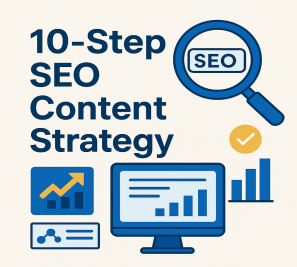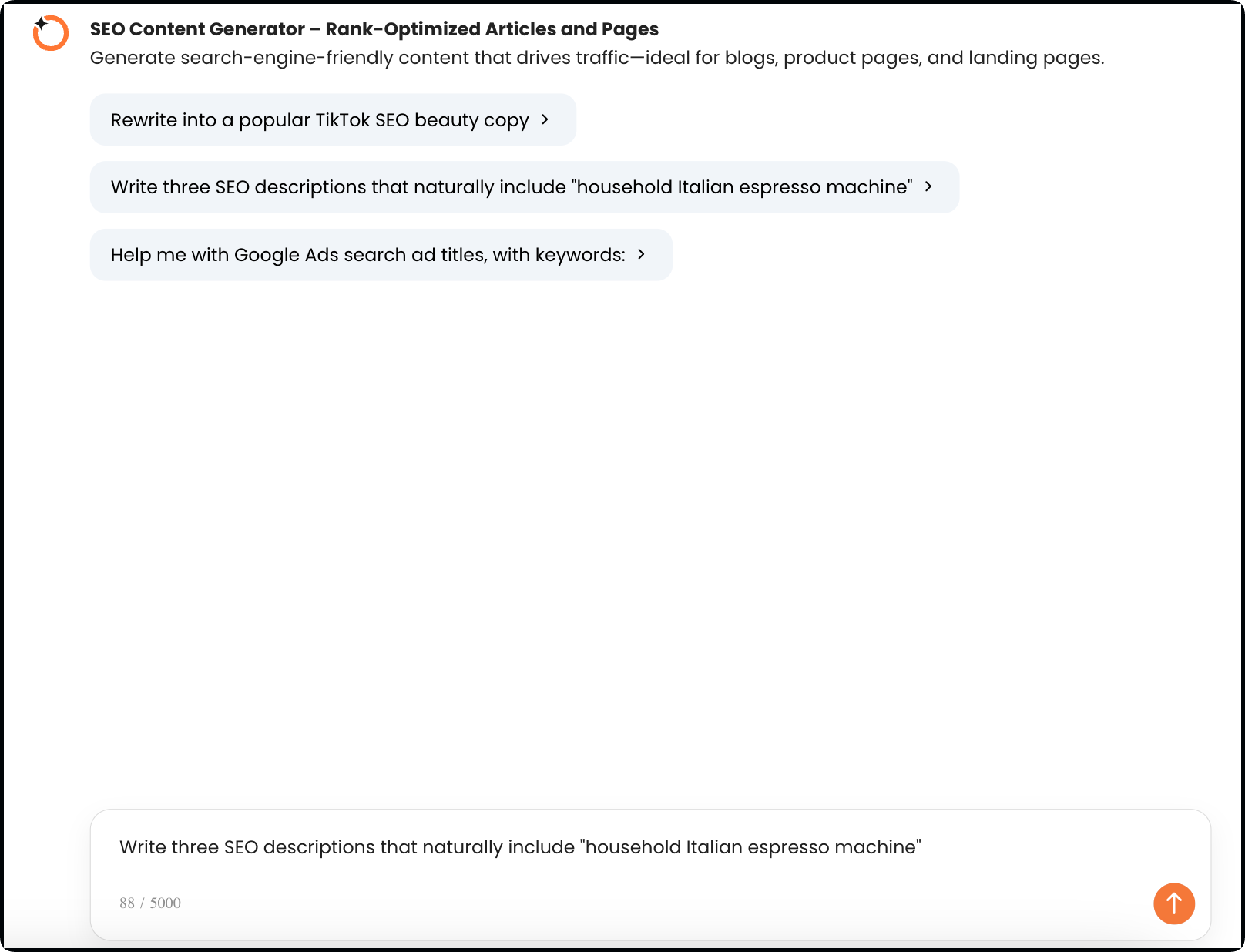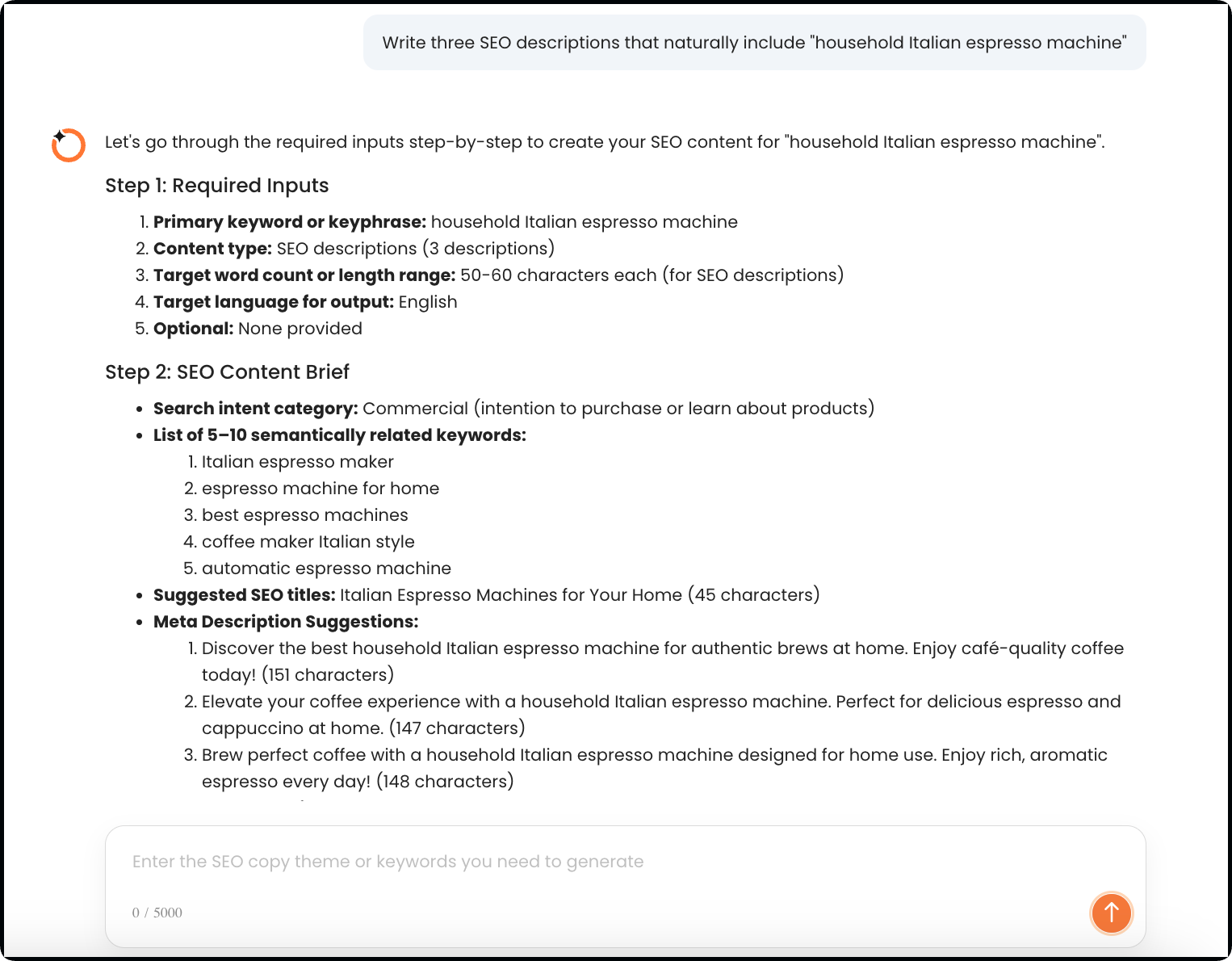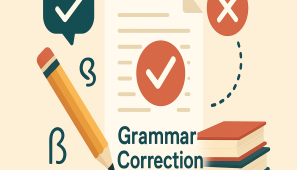When you’re trying to boost your website’s prominence in search engine rankings, it’s good to aim high. But getting to those prized top spots takes work. You need a comprehensive plan built around your audience, relevant keywords, and user intent.
(Click the picture to try Oreate AI SEO Content Generator⬆️)
A well-crafted SEO content strategy is crucial for improving your search engine rankings and driving organic growth. This involves understanding your audience, identifying the right keywords, and staying updated with the ever-changing search landscape.
By following a structured approach, you can create a powerful online presence that resonates with your target audience and search engines alike.
The Power of Strategic SEO Content
A well-crafted content strategy for SEO is no longer a luxury, but a necessity for businesses aiming to rank higher in search engine results. In today’s digital landscape, the importance of strategic SEO content cannot be overstated. It’s about creating content that resonates with your audience and satisfies the search engines’ algorithms.
At its core, a comprehensive SEO strategy comprises four key components: On-page SEO, Off-page SEO, Technical SEO, and Content SEO. Content SEO is particularly crucial as it involves the creation of content that readers want to consume. This not only drives engagement but also encourages sharing and linking, which are vital for Off-page SEO.
Why Content Remains King in SEO
Content remains at the forefront of SEO because it directly addresses the needs and queries of your target audience. By focusing on quality content creation, you’re not just improving your search engine rankings; you’re also building trust and credibility with your audience.
The table below highlights the key reasons why content is paramount in SEO:
| Reason | Description | Impact on SEO |
|---|---|---|
| Relevance | Content that is relevant to your audience’s needs | Increases engagement and reduces bounce rates |
| Quality | High-quality, well-researched content | Improves credibility and trust with your audience |
| Consistency | Regularly updated content | Tells search engines your site deserves frequent crawling |
The ROI of Well-Executed Content Strategy
Investing in a SEO writing strategy can yield significant returns. By creating content that is optimized for search engines, you’re more likely to increase your online visibility, drive more qualified leads, and ultimately boost conversions.
The return on investment (ROI) of a well-executed content strategy can be substantial. According to various studies, businesses that prioritize content marketing tend to see higher engagement rates, improved brand awareness, and a better ROI compared to those that don’t.
What Makes an Effective SEO Content Strategy?
Crafting a successful SEO content marketing strategy requires a deep understanding of your audience and their needs. To develop an effective strategy, you need to align your content with the search intent and your audience’s needs, covering topics where you have expertise to build authority and make your site a trusted resource.
Defining Your SEO Content Goals
Defining your SEO content goals is crucial to creating a focused content strategy. Your goals should be specific, measurable, achievable, relevant, and time-bound (SMART). Some examples of SEO content goals include:
- Increasing organic traffic to your website
- Improving your website’s visibility for specific keywords
- Generating leads through gated content
- Enhancing your brand’s online presence
By setting clear goals, you can create content that drives real results for your business.
Aligning Content with Business Objectives
Aligning your content with business objectives is vital to ensuring that your SEO content marketing strategy drives meaningful results. To achieve this, you need to understand your business goals and develop content that supports these objectives.
Some key considerations when aligning content with business objectives include:
- Understanding your target audience’s needs and pain points
- Developing content that addresses these needs and pain points
- Using data and analytics to measure content performance
- Adjusting your content strategy based on performance data
By aligning your content with business objectives, you can create a more effective SEO content marketing strategy that drives real results for your business.
Step 1: Conduct Comprehensive Keyword Research
To create an effective SEO blog content plan, you need to start with thorough keyword research. This foundational step helps you understand what your target audience is searching for online, allowing you to tailor your content to their needs.
Keyword research is more than just identifying popular search terms; it’s about understanding the intent behind those searches and aligning your content accordingly. By doing so, you can increase your content’s visibility, drive more targeted traffic to your site, and ultimately boost your search engine rankings.
Tools for Effective Keyword Discovery
Several tools can aid in effective keyword discovery. Some of the most popular include:
- Google Keyword Planner: A free tool that helps you find keywords and get an estimate of search volume.
- Ahrefs: Offers comprehensive keyword research capabilities, including competitor analysis.
- SEMrush: Provides detailed keyword insights and competitor analysis.
- Moz Keyword Explorer: Helps you identify relevant keywords and provides metrics on search volume and difficulty.
| Tool | Key Features | Cost |
|---|---|---|
| Google Keyword Planner | Keyword suggestions, search volume estimates | Free |
| Ahrefs | Comprehensive keyword database, competitor analysis | Paid (starts at $29/month) |
| SEMrush | Keyword insights, competitor analysis, technical SEO audits | Paid (starts at $117.33/month) |
| Moz Keyword Explorer | Keyword suggestions, search volume, difficulty metrics | Paid (starts at $39/month) |
Analyzing Search Intent Behind Keywords
Understanding the search intent behind keywords is crucial. Search intent refers to the reason behind a user’s search query. Are they looking to buy something, or are they seeking information? By analyzing search intent, you can create content that meets the user’s needs, thereby improving your content’s relevance and effectiveness.
For instance, if a user searches for “best SEO practices,” they’re likely looking for information or a guide. You can create a comprehensive article or guide that addresses their query, increasing the likelihood of ranking higher in search engine results.
By combining thorough keyword research with an understanding of search intent, you can develop an SEO blog content plan that resonates with your audience and drives organic traffic to your site.
Step 2: Analyze Your Competitors’ Content Strategy
By examining your competitors’ content strategies, you can identify gaps and opportunities to improve your own SEO efforts. This step is crucial in understanding what works in your industry and how you can leverage that knowledge to enhance your SEO content strategy.
Identifying Content Gaps and Opportunities
To start analyzing your competitors, you need to identify the topics they’re covering and how they’re engaging their audience. Look for:
- Content themes that are performing well
- Keywords they’re targeting
- Gaps in their content that you can fill
- Opportunities to create better, more comprehensive content
Tools like Ahrefs, SEMrush, or Moz can help you uncover what content is ranking well for your target keywords and which pieces are getting the most engagement. This analysis will guide your content optimization efforts.
(Click the picture to try Oreate AI SEO Content Generator⬆️)
Benchmarking Against Industry Leaders
Benchmarking your content against industry leaders helps you understand the standards you need to meet or exceed. Consider:
- The quality and depth of their content
- Their content formats (blogs, videos, infographics)
- How they’re using SEO techniques
- Their engagement metrics (comments, shares, likes)
By benchmarking against industry leaders, you can refine your SEO content strategy to be more competitive. This involves not just mimicking their strategies but also finding innovative ways to stand out.
Analyzing your competitors’ content strategies is not about copying their approach but rather about understanding the landscape and finding your unique place within it. By doing so, you’ll be better equipped to create content that resonates with your audience and improves your search engine rankings.
Step 3: Create Detailed Buyer Personas
Understanding your target audience is key to a successful content strategy, and it starts with creating detailed buyer personas. By developing a deep understanding of your ideal customers, you can tailor your content to meet their needs, concerns, and motivations at each stage of the buyer’s journey.
Understanding Your Target Audience’s Needs
To create effective buyer personas, you need to gather and analyze data about your target audience. This includes demographic information, pain points, goals, and behaviors. The more precisely you know your target audience, the better you can tailor your campaign to meet their needs. You can use various tools and techniques to gather this information, such as customer surveys, social media listening, and analyzing customer feedback.
By understanding your audience’s needs, you can develop a content strategy that resonates with them. This involves creating content that addresses their pain points, answers their questions, and provides value at each stage of the buyer’s journey.
Mapping Content to Customer Journey Stages
Once you have a clear understanding of your buyer personas, you need to map your content to the different stages of the customer journey. This includes the awareness, consideration, and decision stages. By tailoring your content to each stage, you can guide your potential customers through the buying process and increase conversions.
For example, at the awareness stage, you might create educational content that addresses the pain points and challenges of your target audience. At the consideration stage, you could provide more detailed information about your products or services, highlighting how they solve the customer’s problems.
By creating detailed buyer personas and mapping your content to the customer journey stages, you can develop a content strategy for SEO that is both effective and engaging. This approach will help you attract and retain a clearly defined audience, driving profitable customer action.
Step 4: Develop a Content Calendar
Your SEO writing strategy isn’t complete without a content calendar that outlines your content themes and publishing schedule. A content calendar is a vital tool that helps you plan, organize, and schedule content in advance, ensuring that your content creation process is streamlined and efficient.
(Click the picture to try Oreate AI SEO Content Generator⬆️)
Planning Content Themes and Topics
To create an effective content calendar, start by planning your content themes and topics. This involves identifying the types of content that will resonate with your target audience and align with your business objectives. Consider the following steps:
- Identify key themes relevant to your industry and audience interests.
- Develop a list of content topics that fit within these themes.
- Use keyword research to inform your topic selection and ensure relevance.
By doing so, you’ll be able to create a content calendar that is both strategic and tactical, ensuring that your content efforts are focused on high-impact activities.
Establishing Publishing Cadence
Once you have your content themes and topics planned, the next step is to establish a publishing cadence. This involves deciding on the frequency at which you will publish new content. Consider the following:
- Assess your resources and capacity to produce high-quality content.
- Determine the optimal publishing frequency based on your audience’s needs and your content strategy.
- Use your content calendar to schedule and track your content publications.
Establishing a consistent publishing cadence helps maintain audience engagement and supports your overall SEO writing strategy.
By developing a comprehensive content calendar and sticking to it, you’ll be able to manage your workflow more effectively, ensure team alignment, and drive your content strategy forward with clarity and purpose.
Step 5: Craft SEO-Optimized Content
Creating content that is both engaging and optimized for search engines is key to online success. Your seo content marketing strategy hinges on the ability to craft content that not only resonates with your audience but also ranks well in search engine results.
On-Page SEO Best Practices
To ensure your content is SEO-optimized, you need to follow on-page SEO best practices. This includes:
- Using relevant keywords naturally throughout your content
- Optimizing your meta title and description to entice clicks from search engine results
- Utilizing header tags (H1, H2, H3, etc.) to structure your content
- Incorporating internal and external linking to enhance credibility and user experience
- Ensuring your content is mobile-friendly and loads quickly
With the majority of users accessing content on mobile devices, mobile optimization is no longer optional. Here are some strategies to ensure your content is mobile-friendly:
| Strategy | Description | Benefit |
|---|---|---|
| Responsive Design | Ensure that your website design adapts to different screen sizes. | Improved user experience across devices. |
| Mobile-Friendly Content | Use concise paragraphs, larger font sizes, and easy-to-click buttons. | Better engagement and lower bounce rates. |
| Page Speed Optimization | Optimize images, leverage browser caching, and minimize code. | Faster load times and improved search engine rankings. |
By implementing these practices, you improve your content’s visibility and ranking on search engines.
Creating Engaging and Valuable Content
While SEO optimization is crucial, it’s equally important to create content that is engaging and valuable to your audience. Your content should address the needs and concerns of your target audience, providing them with solutions or insights that they find useful.
To achieve this, focus on:
- Understanding your audience’s pain points and interests
- Creating content that is informative, entertaining, or both
- Using a tone and language that resonates with your audience
- Encouraging interaction through calls-to-action or comments
By balancing SEO optimization with engaging content, you can enhance your seo content marketing strategy and drive more meaningful interactions with your audience.
Step 6: Implement Content Optimization Techniques
To take your SEO blog content plan to the next level, you need to focus on implementing effective content optimization techniques. These techniques are crucial for enhancing your content’s visibility and driving more organic traffic to your site.
Technical SEO Elements for Content
Technical SEO is the backbone of any successful SEO strategy. It involves optimizing your website and content to make it search engine friendly. Some key technical SEO elements include:
- Meta Tags: Ensure that each page has a unique title tag and meta description that includes your target keywords.
- Header Tags: Organize your content with header tags (H1, H2, H3, etc.) to improve readability and highlight important keywords.
- Internal Linking: Link to other relevant content on your site to improve user experience and help search engines understand your site structure.
- Page Speed: Ensure that your pages load quickly (less than 3 seconds) to improve user experience and search engine rankings.
(Click the picture to try Oreate AI SEO Content Generator⬆️)
Optimizing for Featured Snippets
Featured snippets are a great way to increase your visibility on search engines. To optimize for them, you need to:
- Use Clear and Concise Language: Answer questions directly and concisely to increase the chances of being featured.
- Use Structured Data: Implement schema markup to help search engines understand your content.
- Optimize for Long-Tail Keywords: Target longer, more specific phrases that have lower competition.
Step 7: Build a Strong Internal Linking Structure
To boost your website’s search engine ranking, it’s essential to develop a strong internal linking structure. This step is crucial for enhancing your site’s visibility and making it easier for Google to understand your content hierarchy.
Strategic Link Placement
Strategic link placement involves carefully selecting where to place internal links within your content. This not only improves user experience but also helps search engines crawl your site more efficiently. When placing internal links, consider the following best practices:
- Link to relevant and related content to add value to your readers.
- Use descriptive anchor text that indicates the content of the linked page.
- Avoid over-linking; too many links can be overwhelming and dilute the importance of each link.
Creating Content Clusters
Creating content clusters is an effective way to organize your content and improve your internal linking structure. A content cluster involves creating a central, comprehensive piece of content (often referred to as a pillar page) and linking it to related, more specific articles or pages (cluster content). This strategy helps search engines understand the relevance and depth of your content.
| Element | Description | Benefits |
|---|---|---|
| Pillar Page | A comprehensive, central piece of content covering a broad topic. | Establishes authority on a topic, improves SEO. |
| Cluster Content | Specific articles or pages linked to the pillar page, covering related subtopics. | Enhances user experience, increases internal linking opportunities. |
| Internal Linking | Links between the pillar page and cluster content, and vice versa. | Improves site navigation, helps search engines understand content hierarchy. |
By implementing a strong internal linking structure through strategic link placement and creating content clusters, you can significantly enhance your website’s content optimization and overall SEO performance.
Step 8: Develop a Link Building Strategy
Enhance your SEO content strategy by incorporating a strategic link building plan. Link building is a critical aspect of SEO that involves obtaining high-quality backlinks from reputable sites within your niche.
To develop an effective link building strategy, you need to focus on creating content that is valuable and linkable. This involves understanding what types of content are likely to be shared and linked back to.
Creating Linkable Assets
Creating linkable assets is about producing high-quality, unique, and informative content that other websites will want to link to. This can include:
- In-depth guides and tutorials
- Original research and data
- Infographics and visual content
- Comprehensive reviews and case studies
By focusing on these types of content, you can increase the chances of attracting backlinks from authoritative sites, thereby enhancing your content strategy for SEO.
(Click the picture to try Oreate AI SEO Content Generator⬆️)
Outreach Techniques for Quality Backlinks
Outreach is a crucial component of link building. It involves reaching out to other website owners, bloggers, or influencers in your niche to promote your content and request links.
Effective outreach techniques include:
- Personalizing your outreach emails to show you’ve done your research
- Offering value in exchange for a link, such as a guest post or collaboration
- Following up politely if you don’t receive a response
By combining linkable assets with strategic outreach, you can build a robust link building strategy that supports your overall SEO content strategy and drives your website’s success.
Step 9: Measure Content Performance
You can’t improve what you don’t measure; hence, tracking content performance is essential for a successful SEO content strategy. Measuring your content’s performance helps you understand what’s working and what’s not, allowing you to make data-driven decisions to refine your approach.
Key Metrics to Track
To effectively measure content performance, you need to track the right metrics. These include:
- Organic Traffic: The number of visitors coming to your site through search engines.
- Keyword Rankings: Your content’s position in search engine results pages (SERPs) for target keywords.
- Engagement Metrics: Time on page, bounce rate, and pages per session indicate how engaging your content is.
- Conversions: The ultimate goal is to drive conversions, whether it’s form submissions, purchases, or sign-ups.
By monitoring these metrics, you can gain insights into your content’s effectiveness and identify areas for improvement.
Tools for Content Performance Analysis
Several tools can help you analyze your content’s performance. Some of the most effective include:
| Tool | Description | Key Features |
|---|---|---|
| Google Analytics | A comprehensive tool for analyzing website traffic and behavior. | Traffic analysis, conversion tracking, audience insights |
| SEMrush | An all-in-one SEO tool that includes content performance analysis. | Keyword ranking, competitor analysis, technical SEO audit |
| Ahrefs | A tool focused on backlink analysis and content performance. | Backlink analysis, keyword research, content gap analysis |
Using these tools, you can gather detailed insights into your content’s performance and make informed decisions to enhance your SEO writing strategy.
By regularly measuring and analyzing your content’s performance, you can refine your SEO content marketing strategy to achieve better results over time.
Step 10: Refine Your SEO Content Strategy
As you implement your SEO content strategy, it’s vital to continually assess and refine it to ensure it remains effective. Refining your strategy involves a thorough review of your existing content to identify areas for improvement.
Content Auditing Process
A content audit is a systematic review of your existing content to determine its quality, relevance, and performance. To conduct a content audit, follow these steps:
- Inventory all your content assets, including blog posts, articles, and landing pages.
- Assess the performance of each piece using metrics such as traffic, engagement, and conversions.
- Identify content that is outdated, irrelevant, or underperforming.
- Determine the necessary actions for each piece, such as updating, consolidating, or removing it.
Regular content audits help you maintain a fresh and relevant content portfolio, which is essential for content optimization and improving your search engine rankings.
Updating Underperforming Content
Updating underperforming content can significantly improve your SEO performance. Here are some strategies to consider:
- Refresh outdated information: Ensure that your content reflects the latest data and trends.
- Improve keyword targeting: Re-optimize your content with relevant keywords, such as “seo blog content plan,” to enhance its visibility.
- Enhance user experience: Make your content more engaging and user-friendly by improving its structure, formatting, and readability.
- Repurpose content: Consider transforming underperforming content into alternative formats, such as turning a blog post into a video or infographic.
By regularly reviewing and refining your SEO content strategy, you can ensure that your content remains competitive and effective in driving organic traffic to your website.
Tools to Execute an SEO Content Strategy
To effectively execute your SEO content strategy, you’ll need the right set of tools to help you research, optimize, and analyze your content’s performance. With the plethora of tools available, you can streamline your content creation process, improve your content’s visibility, and drive more engagement.
1. SEO Research Tools
SEO research tools are crucial for identifying relevant keywords, analyzing competitors, and uncovering content opportunities. Some of the most effective SEO research tools include Google Keyword Planner, Ahrefs, and SEMrush, which were mentioned above. These tools help you discover keywords that your target audience is searching for, analyze your competitors’ content strategies, and identify gaps in the market.
- Google Keyword Planner allows you to find keywords related to your content and get an idea of their search volume.
- Ahrefs provides a comprehensive analysis of your competitors’ backlinks, content, and keyword rankings.
- SEMrush offers a suite of tools for technical SEO audits, competitor analysis, and keyword research.
2. Content Optimization Tools
Content optimization tools help you refine your content to make it more search engine friendly. These tools can analyze your content’s readability, suggest optimizations, and even help with content formatting. Some popular content optimization tools include Yoast SEO, Surfer SEO, and Clearscope.
Below is a quick comparison table of three:
| Tool | Functionality | Benefits |
|---|---|---|
| Yoast SEO | Real-time SEO feedback | Improves keyword usage and meta descriptions |
| Surfer SEO | AI-driven content optimization | Provides data-driven recommendations |
| Clearscope | Content relevance analysis | Enhances content relevance to target keywords |
3. Analytics Tools
Analytics tools are vital for measuring the success of your SEO content strategy. They help you track your content’s performance, understand your audience’s behavior, and make data-driven decisions. Google Analytics is one of the most widely used analytics tools, providing insights into your website’s traffic, engagement, and conversion rates.
4. AI SEO Content Generator
AI SEO content generators, like Oreate AI SEO Content Generator, are revolutionizing the way we create content. These tools use artificial intelligence to generate high-quality, SEO-optimized content quickly and efficiently. They can help you produce content at scale, freeing up your time to focus on other aspects of your SEO strategy.
By leveraging these tools, you can enhance your SEO content strategy, improve your content’s visibility, and drive more engagement with your target audience.
How to Generate SEO Content with Oreate AI?
With Oreate AI, you can streamline your content creation process and improve your SEO content marketing strategy. This AI-powered tool is designed to help you generate high-quality, SEO-optimized content that resonates with your target audience.
A Step-by-Step Guide
To get the most out of Oreate AI, follow this step-by-step guide to generate SEO content effectively.
Step 1. Visit Oreate AI Website: Go to the official platform with no sign-up required.
(Click the picture to try Oreate AI SEO Content Generator⬆️)
Step 2. Input Your Needs: Tell the agent your seo blog content plan to help Oreate AI generate content that is optimized for search engines.
Step 3. Review and Customize: Review the draft first and adjust the tone, style, and length of the content to match your brand voice and audience preferences.
(Click the picture to try Oreate AI SEO Content Generator⬆️)
By following these steps, you can leverage Oreate AI to enhance your content creation process and improve your overall SEO content marketing strategy.
Oreate AI not only streamlines content generation but also helps in creating a cohesive seo blog content plan that aligns with your business goals. With its advanced capabilities, you can produce content that is both engaging and optimized for search engines, thereby increasing your online visibility.
Overcoming Common SEO Content Challenges
As you refine your SEO content strategy, you’ll need to address several common challenges head-on. The ever-evolving landscape of search engine optimization demands adaptability and a proactive approach to content creation and optimization.
1. Dealing with Algorithm Updates
Search engine algorithm updates can significantly impact your content’s visibility. To mitigate this, stay informed about the latest updates and adjust your SEO content strategy accordingly. This involves:
- Monitoring industry news and updates from search engines
- Analyzing the impact of updates on your content’s performance
- Adjusting your content optimization techniques to align with the latest best practices
For instance, when a major search engine updates its algorithm to prioritize user experience, you may need to revisit your content’s structure and formatting to ensure it remains competitive.
2. Managing Content Production at Scale
Managing content production at scale is another significant challenge. To overcome this, plan your content calendar effectively and leverage the right tools to streamline your content creation process. Consider:
| Content Type | Production Time | Optimization Techniques |
|---|---|---|
| Blog Posts | 2-3 days | Keyword research, meta tags optimization |
| Video Content | 5-7 days | Transcription, keyword optimization in descriptions |
| Infographics | 3-5 days | Alt text optimization, embedding relevant keywords |
By understanding the production time and optimization techniques for different content types, you can better plan your content calendar and manage production at scale.
3. Maintaining Content Quality with Limited Resources
Maintaining high-quality content with limited resources is a challenge many face. To address this, focus on repurposing existing content and prioritizing quality over quantity. This might involve:
- Updating outdated content to make it relevant again
- Repurposing successful content into different formats (e.g., turning a blog post into a video)
- Focusing on high-performing content types that resonate with your audience
By adopting these strategies, you can maintain high-quality content even with limited resources, ensuring your SEO content strategy remains effective.
Conclusion
Implementing a successful content strategy for SEO is a multifaceted process that requires dedication and persistence. By following the 10-step guide outlined in this article, you can develop an effective SEO writing strategy that drives organic growth and improves your search engine rankings.
A well-crafted SEO content marketing strategy is not a one-time task, but rather an ongoing effort to create high-quality content, optimize it for search engines, and refine your approach based on performance data. Stay focused on providing value to your audience, and be patient as you work to achieve your SEO goals.
By combining careful planning, high-quality content, and ongoing optimization, you can create a robust SEO content writing strategy that yields long-term results and helps you stay ahead of the competition.
FAQs
How to make an SEO content plan?
Start with keyword research, group keywords into topics, and create content that answers user intent. Optimize titles, meta descriptions, and internal links, then publish consistently. Track results and adjust your plan based on performance.
Which social media is best for SEO?
Social media doesn’t directly boost rankings, but it drives traffic and brand visibility. LinkedIn works well for B2B, while Twitter (X) and Facebook are good for link sharing. Choose the platforms where your audience is most active.
What is the role of keyword research in SEO content strategy?
Keyword research is the first step in creating an SEO content strategy, involving the use of tools for effective keyword discovery and analyzing search intent behind keywords to inform your content creation.
How can I analyze my competitors’ content strategies?
You can analyze your competitors’ content strategies by identifying content gaps and opportunities, as well as benchmarking against industry leaders to refine your own content approach.
How do I develop a content calendar?
To develop a content calendar, you need to plan content themes and topics, as well as establish a publishing cadence that aligns with your business objectives and audience needs.
What are the best practices for crafting SEO-optimized content?
Crafting SEO-optimized content involves following on-page SEO best practices and creating engaging and valuable content that meets the needs of your target audience.
How can I optimize my content for featured snippets?
To optimize your content for featured snippets, you need to understand the technical SEO elements that influence snippet selection and structure your content accordingly.
What tools can I use to execute an SEO content strategy?
You can use a variety of tools, including SEO research tools, content optimization tools, analytics tools, and AI SEO content generators like Oreate AI, to execute and refine your SEO content strategy.
How can I refine my SEO content strategy over time?
Refining your SEO content strategy involves a content auditing process, updating underperforming content, and continually assessing and adjusting your approach to optimize results.











